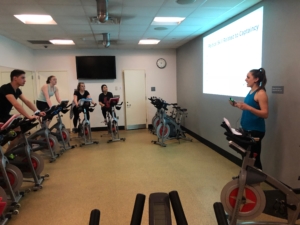It’s not something you hear everyday from a B-school prof, but Julita Haber, a clinical assistant professor in management at Fordham University’s Gabelli School of Business admits it: she’s hyper. In her own words: “I’m quite hyper. I can’t sit still. I remember using a stepper while writing my dissertation.”
With her own hyperactivity and attention span issues to contend with, Haber says when she began her teaching career eight years ago, she really felt badly for students who’d have to sit through three-hour lectures. “I can’t even do that and I know it’s unhealthy,” she adds.
With this in mind, and a passion for exercising, she began to incorporate movement inside her classrooms. “Over a seven-year period, I taught 20 different courses where I used movement in each session,” she says. “It started with interval movement — push ups, jumping jacks, etcetera. I’d take them walking outside, we did intensive running on the track, and some stair climbing.”
Haber then started trying more techniques. From intervals, she moved to an embedded approach where movement and exercise were baked into the course material being taught. For instance, having students use movement and body language to express concepts being learned. Finally, she pushed it to the max — doing movements and exercises while she taught — a technique she’s dubbed “simultaneous.”
Haber gave it a shot in three different universities, earning herself plenty of experience in this arena by the time she arrived at Gabelli three years ago.
LIGHTS DOWN, MUSIC UP
Fast forward to today and Professor Haber has just wrapped up her first full semester using Fitness Integrated Learning, a term she uses to describe courses that use her simultaneous technique.
 The class is a standard management elective with one caveat: it’s taught in an exercise studio as students cycle on actual exercise spin bikes. Research in Management: Managing Professional Relationships, as it’s titled, has students look at Ph.D.-level research studies to help bring impression management skills to life.
The class is a standard management elective with one caveat: it’s taught in an exercise studio as students cycle on actual exercise spin bikes. Research in Management: Managing Professional Relationships, as it’s titled, has students look at Ph.D.-level research studies to help bring impression management skills to life.
“It works on impression management and political skills by diving into doctoral-level research content,” Haber tells Poets&Quants for Undergrads. “It also goes into data analysis, findings, and research design, but uses the content to help students make better impressions in the workplace and to develop better relationships.”
But that’s not all. Haber says there are three overall pillars to the course which was recently featured on Good Morning America. “First is physical activity for students to be both active and cognitively engaged,” Haber begins. “Second is an intro to research design and methodology — almost always on a doctoral level. Third is for students to be able to apply the research findings in their own ways such as how they handle themselves on the job and in school, body language, impressions, tactics, motivations, and outcomes.”
On the physical activity front, it’s a unique learning experience complete with lights dimmed, music pumping, and a student DJ/motivator newly designated each class period to lead the class during the different activity intervals.
The class, which takes place every Monday and Thursday at 8:30 a.m., begins with stretching and warm-ups during which Huber shares class announcements and a review of material from the previous class.
“At that time I have a two-minute intense interval,” Haber says. “While they’re spinning intensively, there’s on-screen content with new material. While spinning, they’re already subconsciously taking in a new concept that is to come after this intense two minutes, then for three 20-25 minute buckets, I lecture as they spin at their own pace. But I do a lot of participation. I’ll have them get off the bikes, share something, or present their ideas. I also provide the PowerPoint slides as handouts so the students can highlight key points and take notes while they spin.” In other words, Haber says it’s a very interactive, very participative experience to ensure students know the concepts that are being covered.
“Oh, it’s really fun,” Haber says. “We laugh, we dance, sometimes we put on some international music. But, when I lecture, I have their full attention which is really amazing.”












Questions about this article? Email us or leave a comment below.